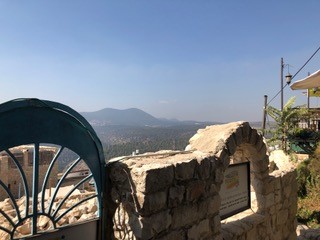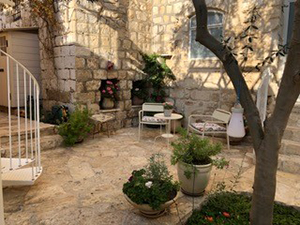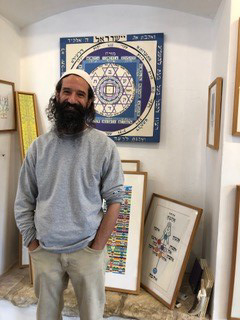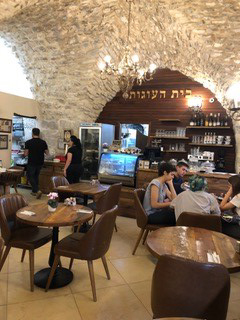
By Steve Kramer
 KFAR SABA, Israel — If you were going away by car for a few days, could you have lunch at a 2,000 year old seaport, once the most modern in the world? Or, could you spend a few days in a Holy City which once was – and still might be – the center of the Kabbala movement? Recently, Michal and I enjoyed a 3-day getaway in northern Israel doing those things.
KFAR SABA, Israel — If you were going away by car for a few days, could you have lunch at a 2,000 year old seaport, once the most modern in the world? Or, could you spend a few days in a Holy City which once was – and still might be – the center of the Kabbala movement? Recently, Michal and I enjoyed a 3-day getaway in northern Israel doing those things.
On the way north we decided to stop at Caesarea National Park to briefly look around and then enjoy a delicious lunch at one of the many cafes on the Mediterranean, situated adjacent to the ancient Crusader fort and the Roman ruins. Straton’s Tower, the city’s original name, was founded during Persian rule (586-332BCE). It eventually was annexed by the Jewish Hasmonean Kingdom (think Maccabees) under the rule of Alexander Jannaeus in 103BCE, only to shortly later become subject to Roman rule in Judea.
Caesarea became the Roman world’s greatest seaport when the its client monarch, Herod the Great (74-4BCE), completed the transformation of the original small town into a grandiose Roman city. Its harbor was built using unique, advanced engineering methods rapidly (23-15BCE) and called Sebastos (Greek for Augustus) to honor the Emperor Augustus Caesar.
“Sebastos was the largest artificial harbor ever built in the open sea up to that point. The scale and complexity of this project, along with the rapidity of its execution, are remarkable even if judged by modern standards. It ranks as one of the most impressive engineering accomplishments of the Augustan Age.” See more about the port at this link.
Before leaving the park, we stopped by the “new” Visitors Center, built in a 2,000-year-old building, to see its collection of artifacts, but mostly to enjoy the short film which is shown there, in English and in Hebrew. A trip to Caesarea is a must for first time visitors to Israel. We have been there many times during our 30 years residence and it never disappoints, with new developments annually.

After leaving Caesarea, we drove north into the mountainous region of the Galilee to Tzfat (also known as Safed), 2953 feet in elevation. Because it overlooks the Sea of Galilee which is 700 feet below sea level, Tzfat seems even loftier. We were staying at a zimmer, which is what Israelis term a room to rent in a residence. Our choice was the delightful Azamra Inn, where we were hosted by a religious couple, Shlomo and Talia.
Just now I received a lovely, brief note from Shlomo: Shalom dear Steve & Michal, dear guests, dear friends, holy brother and sister, Thank you for coming here, and thank you Hashem for sending you. Azamra means – I will sing! Et cetera.
Our hosts had relocated from Jerusalem to Tzfat (population 36,000) several years before and had dedicated themselves to reclaiming a disheveled and neglected stone enclave (house and courtyard) into a delightful home for themselves with several rooms for visitors. Talia’s vocation as a designer was quite evident in the design and decor of the restful lodging, especially the fact that the courtyard was just a delightful place to rest in the late afternoon. The Azamra Inn is located in the Artists Colony of Tzfat’s Old City.
Tzfat first appeared in Jewish sources in the late Middle Ages. It is mentioned in the Jerusalem Talmud as one of five elevated spots where fires were lit to announce the New Moon and festivals during the Second Temple period. It is most famous as the place where the study of Kabbalah emerged. Famous rabbis like Joseph Caro and Issac Luria (H’Ari — the Lion) lived in Tzfat in the 16th century. Residents and tourists can visit the tiny synagogues associated with both of these giants, as well as many other unique synagogues and artistic venues. Tzfat has the highest elevation of any Israeli city. It’s population is also among the country’s youngest and poorest.
Just 25 years after the 1492 expulsion from Spain, the Ottomans conquered Palestine and the Sultan invited the Jews to move there to enrich his empire. Some came to Tzfat, to capitalize on the already existing terraces, flour mills, water channels, and bridges next to the Amud River. The Jews created a center for the production of high-quality, felted woolen fabrics by converting the flour mills into felting mills. The woolens were then exported to customers all over Europe. Rabbi David de Rossi, who visited Tzfat in 1535, wrote: “Many Jews are arriving all the time and the clothing [textile] business is growing every day… and every man and woman who works in wool at any trade will earn a good living.”
However, in 1576-77, Sultan Murad III, the first anti-Jewish Ottoman ruler, ordered the deportation of many of the Jews of Tzfat to Cyprus, leading to the decline of the woolen industry in the area. Eventually, Arabs became predominant in Tzfat. The city didn’t regain its Jewish majority until Israel’s War of Independence.
In the last few decades, the town has taken on a creative, artistic, slightly hippie atmosphere, with many colorfully garbed newly-religious residents. Since the 1950s, Tzfat has always had an active artists’ colony. In addition to these groups, there is a large Hasidic community.
To come to Tzfat is to step back in time, to walk along crooked alley ways, to visit art galleries, to enjoy the mountainous vistas, to relax, and just to “chill.” One way to chill is to visit one of the many wineries that are found throughout the Galilee (and all over Israel). We stopped at the Abouhav Winery, just off Tzfat’s main pedestrian alley. It’s located on the site of a 600-year-old wine cellar, which the young founders of the winery completely rehabilitated and enlarged. We spoke at length with the father of one of the owners. Nissim gave us a tour of the facility, and of course, a sampling of their excellent wines. The fact that the owners invested in this centuries-old site attests to the hopes of Tzfat’s energetic younger generation.

A highlight of our visit was at the Tzfat Gallery of Mystical Art, which features the Kabbalistic art of Avraham Loewenthal, originally from Detroit. He explained the basic spiritual motifs behind his artwork, each of which is an artistic interpretation of a deeply mystical teaching. Avraham has many renditions of his artistic focus on display, in various sizes and prices.
Ordinarily Avraham hosts numerous visiting Birthright groups; he was expecting one later that day. Now, to get even one group is an event because of the pandemic. Tzfat has had very few tourists from abroad during this period. Locals are coming, but many of them are religious families who stay for the weekend. But, on Friday night and Saturday (Shabbat) they are forbidden to spend money, depriving the city of much needed tourist income. Avraham and his fellow merchants are hopeful that the pandemic is petering out and that Tzfat’s narrow streets will soon bustle with tourists of all kinds, from many countries.
Another place we enjoyed touring was the Build & Be Built underground tunnel tour (Livnot U’Lehibanot), whose center was located among the souvenir shops, galleries, and other stalls in a busy, narrow Old City alley. Describing itself as, “A journey through the tunnels of ancient Tzfat,” it’s an educational service project, primarily aimed at young Jews.
From its brochure: “The tunnels you are visiting are the result of the exposure of ancient rooms and water cisterns dating back to the 16th century which were covered underground for about 100 years. The tunnels connect to the ‘Beit Hakahal’ area – the remains of an ancient neighborhood from the 16th century. The archaeological exposure of the tunnels and buildings in ‘Beit HaKahal’ was carried out over the years with the assistance of thousands of young Jewish volunteers from Israel and abroad who operated as part of the educational volunteer programs run by Livnot U’Lehibanot.”

Not to be forgotten – food. The first night we went to a funky street food restaurant just steps away from our inn. A simple breakfast was included with our room, so we decided to have an early lunch a few hours later. We happened upon the nearby House of Cookies Cafe (Beit Haogiot) on the way to the main commercial alley of the Old City. We had an excellent lunch in the nicely decorated cafe, located in a building from the same era as our lodging. That night, tired after a busy day, we ate a simple meal in the inn’s courtyard. In the morning we returned to the same cafe for an excellent breakfast.
After some more touring throughout the old alleys, we paid a visit to “Ascent,” a hotel with educational programs run by Chabad, the ubiquitous Hasidic movement that’s located just about anywhere Jews might show up. There we toured their small but informative Kabbalah exhibit. Returning to our inn via the short main street of Tzfat, we noted the difference between the town center and that of our town, Kfar Saba, a much larger and more prosperous city, located in the Tel Aviv Metro area. There’s no doubt that the Galilee area needs more middle-class Israelis, which would bring the industry and facilities that would be built in their wake.
Eventually, we found our way back to the inn, retrieved our car and headed south to Kfar Saba. Luckily for us, we missed most of the afternoon rush hour and arrived to our apartment in two hours. Our “getaway” was fun, educational, and entertaining. Visitors to Israel, first-timers and veterans, should make sure that both Caesarea and Tzfat are on their itineraries!
*
Steve Kramer is a freelance writer who made aliyah to Israel from New Jersey in 1991. He may be contacted via steve.kramer@sdjewishworld.com